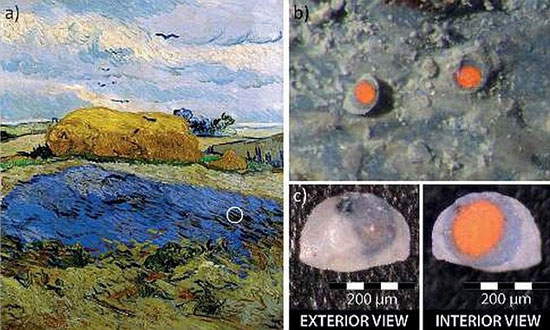Van Gogh: the red in his paintings turns white over time. Scientific research reveals why
In an article published last Feb. 20 in the German scientific journal Angewandte Chemie, a group of researchers from theUniversity of Antwerp (Frederik Vanmeert, Geert Van der Snickt and Koen Janssens), confirmed what has long been known: that many paintings made by Vincent van Gogh (1853 - 1890) have already faded and are in danger of losing their colors with the passage of time. The scientific proof came following a study of a painting by the great Dutch artist kept at the Kröller-Müller Museum in Otterlo, the Netherlands: the Wheat Sheaf under a Cloudy Sky, painted in 1889. In this painting, the leaves of the pond, while originally marked by a bright, autumnal red, now took on colors similar to those of the clouds we see in the sky.
 |
| Vincent Van Gogh, Sheaf of Wheat under a Cloudy Sky; 1889; Otterlo, Kröller-Müller Museum |
We were saying that it had long been noticed that portions of certain Van Gogh paintings have faded: the three Antwerp chemists have discovered why. To paint his reds, Van Gogh made extensive use of miniature, a lead oxide that has always been widely used in the history of art: suffice it to say that the term miniature comes from the very name of this pigment. Researchers noticed that in the Dutch museum painting, the minium was converted to plumbonacrite, a mineral derived from lead that, when in contact withcarbon dioxide in the air, reacts to form small white crystals and thus causes the loss of the original color.
Professor Janssens, leading the team, explains in the article that this is the first time that plumbonacrite, an otherwise rather rare mineral, has been found in a painting made before the mid-20th century. In the research, the discovery is referred to as the"missing link" to explain the degradation of plumbonacrite. The discovery was made possible through the use of a special method of analysis, X-ray tomography, which by projecting an X-ray beam onto samples of the painting, allows it to be studied from different positions and thus obtain information in order to accurately reconstruct the materials from which the painting is made. The researchers also released some images demonstrating the discovery. In image A we see, circled, the sample on which the scholars conducted the research. In images B and C, on the other hand, we see some fragments of plumbonacrite: where it was protected from the air, because it was covered with other pigments, it retained its red color (B), while in areas exposed to the air, it turned completely white (C).
 |
| The images released by researchers at the University of Antwerp |
The question that arises is: why did the minium turn into plumbonacrite? It is likely that the degradation was due to the presence of impurities in the original pigment, which would have triggered the process. Bluntly, a Times article a few days ago titled, “Van Gogh’s reds fade because the painter used cheap dyes.” Indeed, it is well known that Van Gogh used industrial colors extensively. Some of those reds were probably produced with, indeed, elements that would have compromised the stability of the color over time.
What does this discovery entail? Meanwhile, it is animportant indication for museums, which will be able to modify the environments in which works are stored to slow the degradation process significantly. And also, it could help restorers in their work, although there are those who express opposition to the problem of restoring works to their original hues: this is the case of Francesca Casadio, an Italian chemist at theArt Institute of Chicago, who, in addition to supporting the hypothesis that responsible for the degradation of the colors in Van Gogh’s work was precisely the way the pigments were produced, declares in aninterview with Public Radio International that an intervention aimed at “restoring the original reddish hues” would not be considered ethical and that “digital technologies allow us to see how the artist originally made his paintings.” And on this aspect of art history, we know how thorny the debate is.... !
Warning: the translation into English of the original Italian article was created using automatic tools. We undertake to review all articles, but we do not guarantee the total absence of inaccuracies in the translation due to the program. You can find the original by clicking on the ITA button. If you find any mistake,please contact us.





























